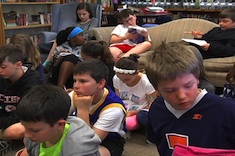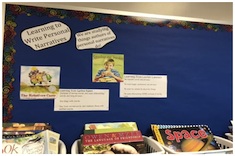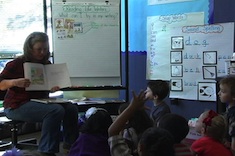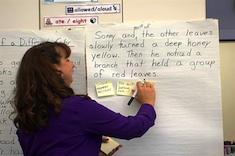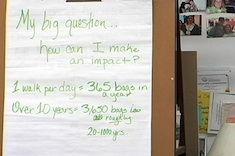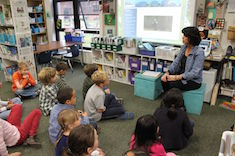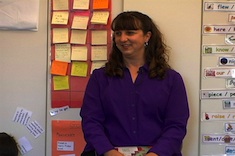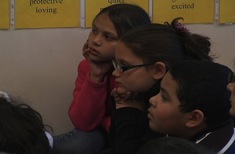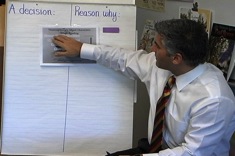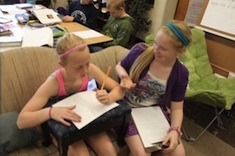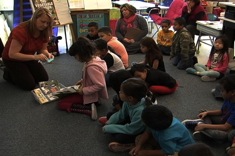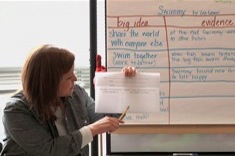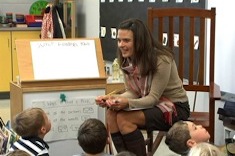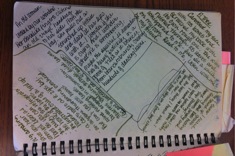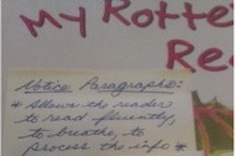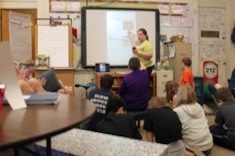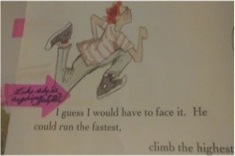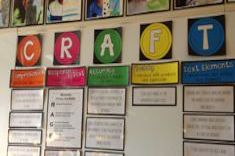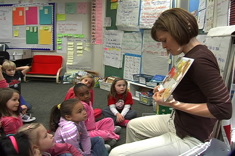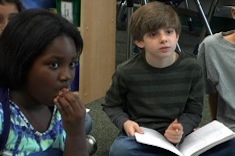Minilessons
Keeping it short, relevant, and meaningful is the challenge when it comes to designing lessons. Here is where you'll find practical advice and dozens of video examples of master teachers in action.
Latest Content
Quick-Write with a Video Prompt
Katherine Sokolowski refreshes the quick-write routine in her fifth-grade classroom by using a video as a prompt.
Planning for a Narrative Writing Unit of Study
Franki Sibberson believes planning a unit of study should be just as much fun as planning a trip to Disney World. She explains her planning process for one of her first units of study, on narrative writing.
First-Grade Minilesson: Reading Like Writers
Bitsy Parks teaches her first graders early in the year how to read like writers, highlighting examples from favorite mentor texts.
Minilesson: Writing a Mentor Text
In this week’s video, Gigi McAllister models writing in front of her fourth-grade class. She takes advice from students as she develops the characters in her story.
Teaching Students to Start at the Right Place
Melanie Meehan uses focus questions for teaching students to start at the right place in their writing, moving them beyond the bed-to-bed stories that plague so many literacy workshops.
Minilesson on Facts and Sources
Katherine Sokolowski presents a minilesson on ferreting out facts while completing independent research projects.
Increasing Student Engagement During Minilessons
Melanie Meehan has tips for keeping students engaged during minilessons.
Celebrating Completed Books and Presenting New Ones
Gigi McAllister shares a quick daily routine of asking students to celebrate books they have finished reading before she introduces a new book to the class.
Teaching Revision Strategies: Introduction and Modeling
Heather Rader shares a process for teaching peer editing and revision skills that helps students learn how to assist each other kindly during writing workshop. This is the first video in a three-part series.
Debating How to Begin Stories
Melanie Meehan shares a minilesson using student writing as a model for experimenting with leads.
Understanding Character Traits: Part 2
Jason DiCarlo continues his third-grade reading workshop lesson on character traits with a mentor text. This is the second video in a three-part series.
Understanding Character Traits Lesson
Jason DiCarlo leads a lesson in third grade on character traits. This is the first video in a three-part series.
Engaging a Room Full of Third Graders
Melanie Meehan works with a third-grade teacher to rouse interest from a class of compliant students who lack engagement.
Ways into Personal Narratives
Katherine Sokolowski describes some Ways into Personal Narratives that use visual tools to build the home/school connection and stronger prewriting skills.
Understanding Fiction and Nonfiction in First Grade
This is a demonstration lesson in a first-grade classroom on understanding the difference between fiction and nonfiction led by Erin Quealy. It is the first video in a three-part series.
Choices for Paragraphs
Melanie Meehan finds third grade is a good age for helping students develop paragraphing skills.
Second-Grade Minilesson on Paragraphs
Ruth Ayres uses a student text to demonstrate the importance of paragraph breaks in this second-grade minilesson.
Big Idea: First-Grade Lesson
Bitsy Parks introduces her first graders to the concept of theme.
Shared Writing in Kindergarten
Mandy Robek leads a shared-writing session in kindergarten.
Giving Students a Notebook Tour
Melanie Meehan finds a notebooks tour is a terrific minilesson for helping students expand the ways they use notebooks.
Organizing Craft Minilessons
Mary Helen Gensch concludes her series on crafting your own minilessons with tips on organizing and storing your plans.
Integrating Short Videos into Minilessons
Katherine Sokolowski gives advice on how to add video to your literacy minilessons.
How to Notice: Mining Children’s Books for Craft Minilessons
This is the second installment in our new series on creating your own writer’s craft minilessons.
Finding Craft Minilessons in the Children’s Books You Love
Mary Helen Gensch explains how to find craft lessons in beloved children’s books. She uses a mentor text with an engaging main character to describe the process. This is the first installment in a three-part series.
Making Space: Entering Lessons Mindfully
Jan Burkins and Kim Yaris explain how to slow down and enter lessons more mindfully. This is the first installment in a three-part series on mindfulness in classrooms.
Introducing Onomatopoeia Minilesson
Christi Overman teaches her second graders about onomatopoeia in a brief minilesson.
Understanding Study: Noticing Pictures
Katie DiCesare’s favorite beginning unit with first graders focuses on illustration.
Endings Minilesson with Second Graders
Cathy Laker uses her own writing as a mentor text with her second-grade students to demonstrate options for endings.
Manipulating Time: Fourth-Grade Writing Minilesson
Tony Keefer uses his writing as a mentor text in this fourth-grade minilesson on manipulating time in personal narratives.
Owl Research Word Study
Andrea Smith leads a whole-class discussion of recording new content vocabulary in reading notebooks.
Browse Content By
Type
Category
- Assessment Tools
- Big Fresh Archives
- Booklists
- Choice Numeracy
- Classroom Design
- Common Core
- Community Building
- Conferring
- Content Literacy
- Digital Literacy
- English Language Learners
- Equity
- Family Relations
- Free Samples
- Guiding Groups
- Leadership
- Literacy Coaches
- Mentor Texts
- Minilessons
- New Teacher Mentors
- Podcasts
- Poetry
- Quote Collections
- Reading Strategies
- Self Care
- Struggling and Striving Learners
- Talking and Listening
- Teacher Study Groups
- Teaching Reading
- Teaching Writing
- Word Study and Vocabulary
Author
- Melissa Quimby
- Nawal Qarooni
- Gwen Blumberg
- Julie Cox
- The Lead Learners
- Hannah Tills
- Josie Stewart
- Ruth Metcalfe
- Mallory Messenger
- Becca Burk
- Jodie Bailey
- Vivian Chen
- Mary Brower
- Tiffany Abbott Fuller
- Stephanie Affinito
- Ruth Ayres
- Leigh Anne Eck
- Heather Fisher
- Shari Frost
- Julie Johnson
- Suzy Kaback
- Gigi McAllister
- Shirl McPhillips
- Melanie Meehan
- Cathy Mere
- Debbie Miller
- Tara Barnett and Kate Mills
- Tammy Mulligan
- Dana Murphy
- Bitsy Parks
- David Pittman
- Brenda Power
- Heather Rader
- Matt Renwick
- Mandy Robek
- Christy Rush-Levine
- Gretchen Schroeder
- Jen Schwanke
- Brian Sepe
- Katherine Sokolowski
- Stella Villalba
- Jennifer Vincent
Grade Level
Choice Literacy Membership
Articles
Get full access to all Choice Literacy article content
Videos
Get full access to all Choice Literacy video content
Courses
Access Choice Literacy course curriculum and training

